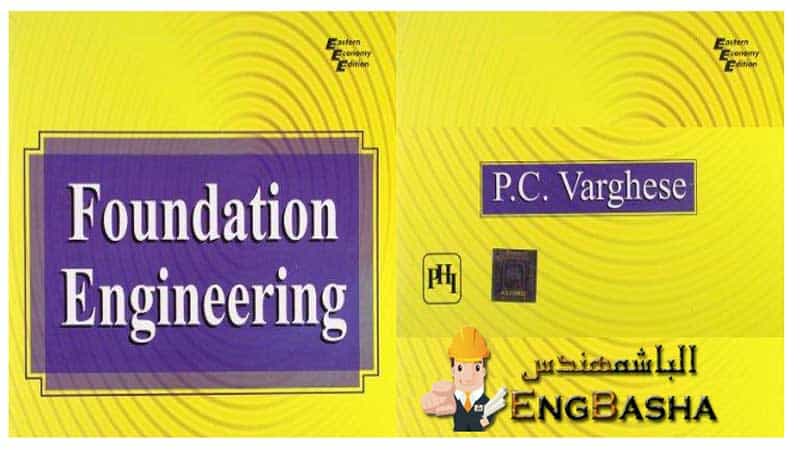
كتاب هندى مهم فى الاساسات للدكتور P.C Varghese :-
وفيه الكثير من المواضيع المهمه منها كيف يمكن زرع الاعمده على الميدات لتلاشى الحفر عند الجار وكذلك التدعيم وزرع الاعمده للمبانى القائمه تصميم اللبشه وعمل ال pedestal والمهمه فى الحل ببرنامج السيف وتأثير الزلازل على الاساسات كل ذلك بالتصميم بالكود البريطانى والكود الهندى
Description:
Foundation Engineering is of prime importance to undergraduate and postgraduate students of civil engineering as well as to practising engineers. For, there is no construction – be it buildings (government, commercial and residential), bridges, highways, or dams – that does not draw from the principles and application of this subject. Unlike many textbooks on Geotechnical Engineering that deal with both Soil Mechanics and Foundation Engineering, this text gives an exclusive treatment and an indepth analysis of Foundation Engineering. What distinguishes the text is that it not merely equips the students with the necessary knowledge for the course and examination, but provides a solid foundation for further practice in their profession later. In addition, as the book is based on the Codes prescribed by the Bureau of Indian Standards, students of Indian universities will find it particularly useful. The author is specialized in both Soil Mechanics and Structural Engineering; he studied Soil Mechanics under the guidance of Prof. Terzaghi and Prof. Casagrande of Harvard University – the pioneers of the subject. Similarly, he studied Structural Engineering under Prof. A.L.L. Baker of Imperial College, London, the pioneer of Limit State Design. These specializations coupled with over 50 years of teaching experience of the author make this text authoritative and exhaustive. Intended as a text for undergraduate (Civil Engineering) and postgraduate (Geotechnical Engineering and Structural Engineering) students, the book would also be found highly useful to practising engineers and young academics teaching the course. CONTENTS: Preface Acknowledgements. Introduction. Units. 1. Engineering Properties of Soils. 2. Contact Pressures on Base of Footings. 3. Stress Distribution in Soils. 4. Settlement of Foundations. 5. General Requirement of Shallow and Deep Foundations. 6. Bearing Capacity of Shallow Foundations. 7. Factors Affecting Bearing Capacity of Shallow Foundations. 8. Design of Raft Foundations. 9. Load Carrying Capacity of Piles by Static Formulae. 10. Load Carrying Capacity of Piles by Dynamic Formulae. 11. Structural Design of Concrete Piles. 12. Construction of Cast in-situ Piles. 13. Group Action and Lateral Resistance of Vertical Piles. 14. Field Tests on Piles. 15. Piled Raft Foundations. 16. Lateral Earth Pressures on Rigid Walls. 17. Effect of Superimposed Loads on Backfill and Empirical Design of Retaining Walls. 18. Floating Foundations. 19. Foundations for Steel Towers and Chimneys. 20. Well Foundations. 21. Foundation on Shrinking (Expansive) Soils. 22. Flexible Retaining Structures-Sheet Pile Walls and Braced Excavations. 23. Design of Machine Foundations. 24. Stability of Slopes. 25. Ground Improvement Techniques. 26. Reinforced or Mechanically Stabilized Earth (MSE). 27. Soil Exploration-Geological Investigation of Sites. 28. Site and Soil Investigation Reports. Appendix A. Determination of Contact Pressure Distribution in Soils and Analysis of Beams on Elastic Foundations by Influence Charts. B. ACI Method for Analysis of Beams and Grids on Elastic Foundations. C. Analysis of Flexible Plate on Elastic Foundations. D. Cyclic Load Tests and Estimation of Settlement in Piles. E. Building Foundations in Theory and Practice. Index. Printed Pages: 592. Bookseller Inventory # 12313
About this title:
Synopsis: Foundation Engineering is of prime importance to undergraduate and postgraduate students of civil engineering as well as to practising engineers. For, there is no construction – be it buildings (government, commercial and residential), bridges, highways, or dams – that does not draw from the principles and application of this subject. Unlike many textbooks on Geotechnical Engineering that deal with both Soil Mechanics and Foundation Engineering, this text gives an exclusive treatment and an indepth analysis of Foundation Engineering. What distinguishes the text is that it not merely equips the students with the necessary knowledge for the course and examination, but provides a solid foundation for further practice in their profession later. In addition, as the book is based on the Codes prescribed by the Bureau of Indian Standards, students of Indian universities will find it particularly useful. The author is specialized in both Soil Mechanics and Structural Engineering; he studied So
“About this title” may belong to another edition of this title.
أو

